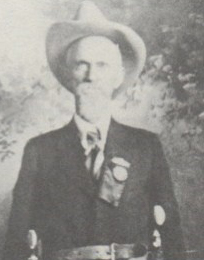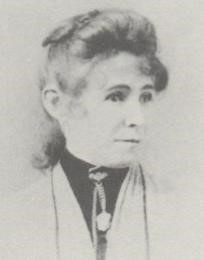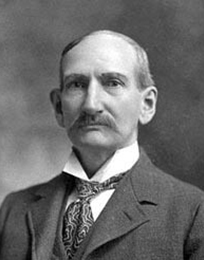
Allen H. Parmer dressed for what might have been a Civil War Reunion. He lived from 1849-1929, most of the time in the saddle.
It wasn’t the content of the story that was so eerie, but the coincidence that when I read it, the time lapse was almost forty-one years to the day after my mother’s death. But let me start at the beginning.
My mother, my brother, my husband, our son, and I love to read. When I travel I tend to buy books as souvenirs and generally have two or three books going at the same time. Last weekend I picked up Tales of Texoma: Episodes in the History of the Red River Border, edited by Michael L. Collins (Wichita Falls, Texas: Midwestern State University Press, 2005). It’s full of wonderful stories about life in the late 19th century on both sides of the Red River. At first “Kin to Outlaws: The Lives of Allen and Susan James Parmer” by Everett Kindig seemed to be a typical piece written about Jesse and Frank James and their followers.
The James Brothers were even here in Hunt County after the Civil War. Oral history claims that Dr. Robert Sayle tended to Frank James after he was shot in the leg. The only photograph I have seen of Frank James was taken in McKinney. He was standing on a wooden sidewalk leaning against a post. I can believe he had difficulty standing after leg surgery.

The lovely Susan James Parmer was a delight to everyone she met. She was remembered as a teacher, a nurse to cowhands during an epidemic, and a true friend to her brothers Frank and Jesse James.
But I digress. Susan James Parmer was the younger sister of Jesse and Frank who married Allen Parmer, one of their fellow Civil War guerrillas who followed William Clark Quantrill. In the winter of 1864/65 Quantrill brought his men to northeast Texas between Bonham and Sherman. Some even hid in Black Cat Thicket. That spring most men followed Quantrill back to Missouri while other stayed in Texas.
Allen and Susan married in Clay County, Missouri on November 24, 1870. They were in Clay County, Texas by 1877. Many of Quantrill’s Gang resettled in the Clay County, Wichita County and Archer County areas, as did more than a few Confederate veterans and families. In fact my great-great grandfather Alexander Marion (A.M.) Seay, a disabled Confederate, brought his family to Beaver Creek near the town of Cambridge in Clay County in 1872.
Allen and Susan were in the same vicinity in January 1880 when A. M. Seay went on a rampage, killing three friends before shooting himself. Did Susan and Allen know A. M. Seay?

That distinguished gentlemen was none other than Frank James, the outlaw, and Susan’s older brother. By 1890 the Federal government forgot about the James Gang. Frank spent most of his time in Texas where he, his wife, and son lived in Fort Worth. He actually became a traveling salesman in the area of Wichita Falls where he often visited with Allen Parmer, he friend and brother-in-law. (Find-a-grave)
By 1882 the Parmer family moved to Beaver Creek in Wichita County on land near the Stone Ranch owned by the Stone Land and Cattle Company or the T-Fork Ranch. Luke Wilson purchased a portion of Stone Ranch in Wichita and Clay Counties to form the Wichita Land and Cattle Company. Wilson hired Allen Parmer as foreman.
This was during range wars between cattlemen and homesteaders who wanted to fence their lands for farming. Parmer and his son were involved in some of those encounters.
Now skip ahead to 1912 when A. M. Seay’s son Jeff bought 870.5 acres of grassland west of Archer City. In February of the following year Jeff Seay sent two of his sons, Virgil and Hardy, along with two cowhands and fifty impregnated heifers to the newly acquired Archer County land. After the cattle were bedded down, Hardy and the two hands loaded their horses on the train for the trip back to Montague County. My grandfather Virgil remained in Archer County for fifty years until his death in 1963.
During World War II my mother Evelyn Seay Coley lived with her parents while my father served in the U. S. Army in Italy. Evelyn taught in a one-room schoolhouse on the Luke Wilson Ranch. The school was named for the train siding, Luke Wilson Switch. She told me about driving to teach when the weather was fine but riding her horse during rain and mud. But I learned little about the Luke Wilson Ranch.
My grandmother Maime Matthews Seay was born on Beaver Creek in Wichita County. Over the years she told a few tidbits of 19th century life in Wichita, Archer, Clay and Baylor counties. Virgil told me stories of his childhood, but most related to the cattle business. He wasn’t much for what he considered gossip. I really wish they both had talked more. And I’m always so glad to find a documented piece like “Kin to Outlaws: The Lives of Allen and Susan James Parmer”
